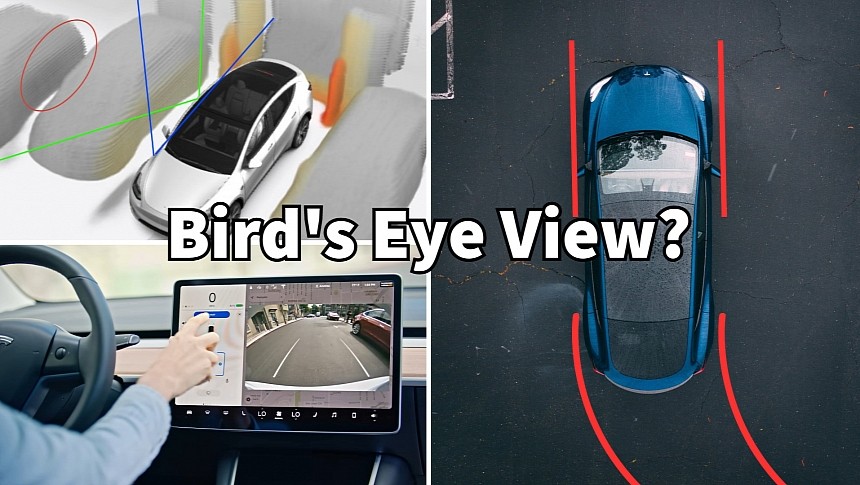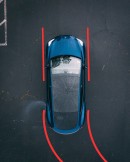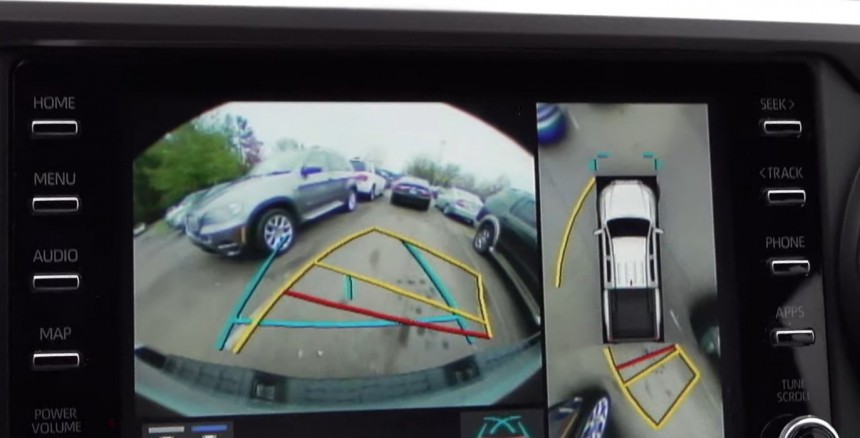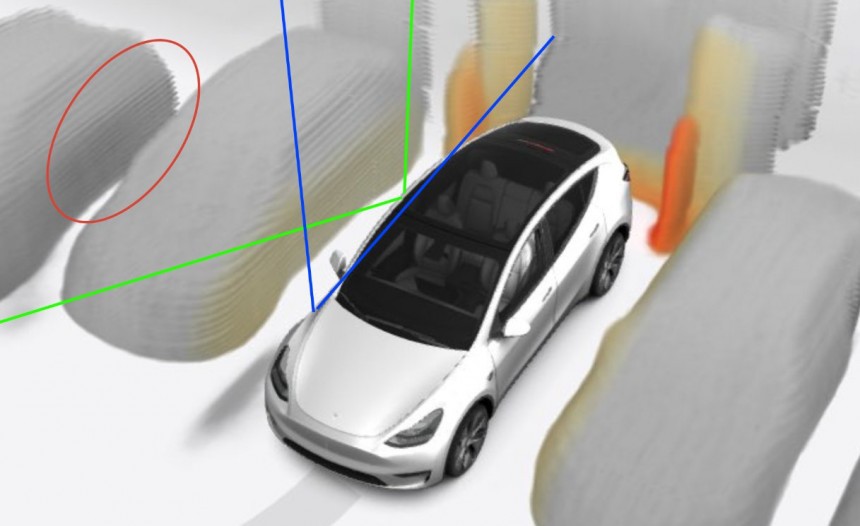The 2023 Holiday update features a new 3D visualization for Tesla Vision parking assistance, which prompted a heated debate about a possible bird's eye view offered on Tesla EVs. However, Tesla will never agree to develop it, no matter how badly owners want it.
Tesla EVs are packed with video cameras, allowing its complex safety assist systems to function. All Teslas have one rear camera, two pillar cameras, two side repeater cameras, and two or three front-facing cameras. More recent models are also fitted with a cabin camera, and the Cybertruck has a front bumper camera, which is so far unique to this model.
Tesla made the cameras more helpful when it launched the Dashcam and Sentry Mode features in 2018 for Autopilot 2.5 and newer vehicles. This way, the car can record videos from the cameras like a stand-alone dash camera would, whether it's parked (Sentry Mode) or in motion (Dashcam). More recently, you can also see the video streams from your onboard cameras in the Tesla app.
What Tesla owners really want is for Tesla to offer a bird's eye view using the many cameras on a Tesla EV. This is available on many car models, including volume models, helping drivers during parking maneuvers. The best Tesla can offer is Multi-Camera View, a feature introduced with the Tesla 2023.26.1 update this summer. It is not a bird's eye view, as you can only see separate video streams from the main cameras and not a stitched-together picture of the car and its surroundings.
Tesla owners have asked for a 360-degree camera view (bird's eye view) for years now. However, there's an important reason why Tesla cannot offer it with the current setup. All cameras on Tesla vehicles have a narrow field of view and cannot cover the 360-degree surroundings. The bird's eye view doesn't require high-definition cameras, as proven on other car models that offer it. Instead, they need a "fish-eye," 180-degree field of view camera. This means that Tesla would need to add four more cameras to its vehicles to offer a bird's eye view, and I don't see this happening.
Some people were convinced that Tesla Vision would finally deliver the 360-degree view they wanted. However, Tesla Vision is still a work in progress, and it's not very good at offering basic parking assistance, let alone a 360-degree view. However, things got a boost with the 2023 Holiday Update, which include a cool 3D visualization called High Fidelity Park Assist. This has the potential to turn into something more valuable than a 360-degree view. Consider it a bird's eye view on steroids, if you will.
If Tesla can leverage Tesla Vision to offer this feature, it will significantly enhance the ownership experience. You can see in the picture shared with the 2023 Holiday Update release notes that the computer 3D-mapped areas that are not visible from the car's current position. This implies that the image was composed of video frames taken earlier while the car was reversing, with the computer "remembering" the objects when it assembled the scene.
However, such a feature might not be as useful as people think, at least not from the driver's perspective. Let's not forget that Tesla is working on a driverless future, and it's made decisions based on that. Tesla removed the ultrasonic sensors in 2022 because it considered them redundant in a driverless car powered by Tesla Vision. It also replaced the steering wheel with a yoke in anticipation of Full Self-Driving becoming widespread and removed the stalks.
While the FSD Beta is still advertised as a "Level-2 driver assistance system," it proved it could offer "supervised autonomy" on city streets. Tesla's automated driving systems can now cover driving on highways and in city traffic, so it's time they learn how to park. Tesla offered a "Smart Summon" feature before, but it wasn't that smart, and it also disappeared when the ultrasonic sensors were removed. Now, it needs a better version of it.
The "Actual Smart Summon" feature could be it. As Elon Musk promised a while ago, Actual Smart Summon (ASS) would allow the car to come when summoned or go park itself without driver supervision. Elon Musk once again confirmed this feature in a reply to a recent bird's eye view discussion on X.
Musk said that Teslas will be able to identify viable parking spaces and park themselves after the drivers confirm the spot. "You tap on one, exit the vehicle, and it parks there," Musk explained. This sounds like a simplified "Reverse Summon," a feature that Tesla promised a year ago. With Reverse Summon, the car would enter "seek mode" at the destination, automatically searching for a spot and parking itself. The "tap to park" feature seems like a regression, as the driver still needs to find the parking space before leaving the car.
The High Fidelity Park Assist feature offered with the Holiday Update may be a sign of what's to come. However, Tesla Vision needs to be significantly improved before it can support reliable autonomous driving. Last but not least, the legislation needs to be updated to allow truly autonomous vehicles to move without a driver, even on the fenced premises of a parking lot.
Tesla made the cameras more helpful when it launched the Dashcam and Sentry Mode features in 2018 for Autopilot 2.5 and newer vehicles. This way, the car can record videos from the cameras like a stand-alone dash camera would, whether it's parked (Sentry Mode) or in motion (Dashcam). More recently, you can also see the video streams from your onboard cameras in the Tesla app.
What Tesla owners really want is for Tesla to offer a bird's eye view using the many cameras on a Tesla EV. This is available on many car models, including volume models, helping drivers during parking maneuvers. The best Tesla can offer is Multi-Camera View, a feature introduced with the Tesla 2023.26.1 update this summer. It is not a bird's eye view, as you can only see separate video streams from the main cameras and not a stitched-together picture of the car and its surroundings.
Tesla owners have asked for a 360-degree camera view (bird's eye view) for years now. However, there's an important reason why Tesla cannot offer it with the current setup. All cameras on Tesla vehicles have a narrow field of view and cannot cover the 360-degree surroundings. The bird's eye view doesn't require high-definition cameras, as proven on other car models that offer it. Instead, they need a "fish-eye," 180-degree field of view camera. This means that Tesla would need to add four more cameras to its vehicles to offer a bird's eye view, and I don't see this happening.
If Tesla can leverage Tesla Vision to offer this feature, it will significantly enhance the ownership experience. You can see in the picture shared with the 2023 Holiday Update release notes that the computer 3D-mapped areas that are not visible from the car's current position. This implies that the image was composed of video frames taken earlier while the car was reversing, with the computer "remembering" the objects when it assembled the scene.
However, such a feature might not be as useful as people think, at least not from the driver's perspective. Let's not forget that Tesla is working on a driverless future, and it's made decisions based on that. Tesla removed the ultrasonic sensors in 2022 because it considered them redundant in a driverless car powered by Tesla Vision. It also replaced the steering wheel with a yoke in anticipation of Full Self-Driving becoming widespread and removed the stalks.
While the FSD Beta is still advertised as a "Level-2 driver assistance system," it proved it could offer "supervised autonomy" on city streets. Tesla's automated driving systems can now cover driving on highways and in city traffic, so it's time they learn how to park. Tesla offered a "Smart Summon" feature before, but it wasn't that smart, and it also disappeared when the ultrasonic sensors were removed. Now, it needs a better version of it.
Musk said that Teslas will be able to identify viable parking spaces and park themselves after the drivers confirm the spot. "You tap on one, exit the vehicle, and it parks there," Musk explained. This sounds like a simplified "Reverse Summon," a feature that Tesla promised a year ago. With Reverse Summon, the car would enter "seek mode" at the destination, automatically searching for a spot and parking itself. The "tap to park" feature seems like a regression, as the driver still needs to find the parking space before leaving the car.
The High Fidelity Park Assist feature offered with the Holiday Update may be a sign of what's to come. However, Tesla Vision needs to be significantly improved before it can support reliable autonomous driving. Last but not least, the legislation needs to be updated to allow truly autonomous vehicles to move without a driver, even on the fenced premises of a parking lot.
True.
— Elon Musk (@elonmusk) December 8, 2023
We are working on a feature where the car identifies probable viable parking spaces. You tap on one, exit the vehicle and it parks there.









